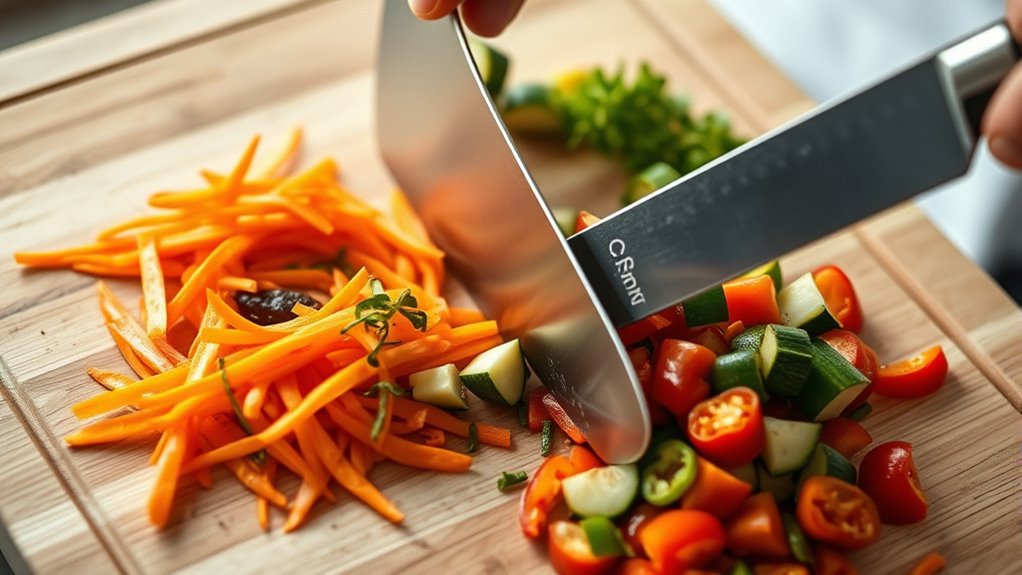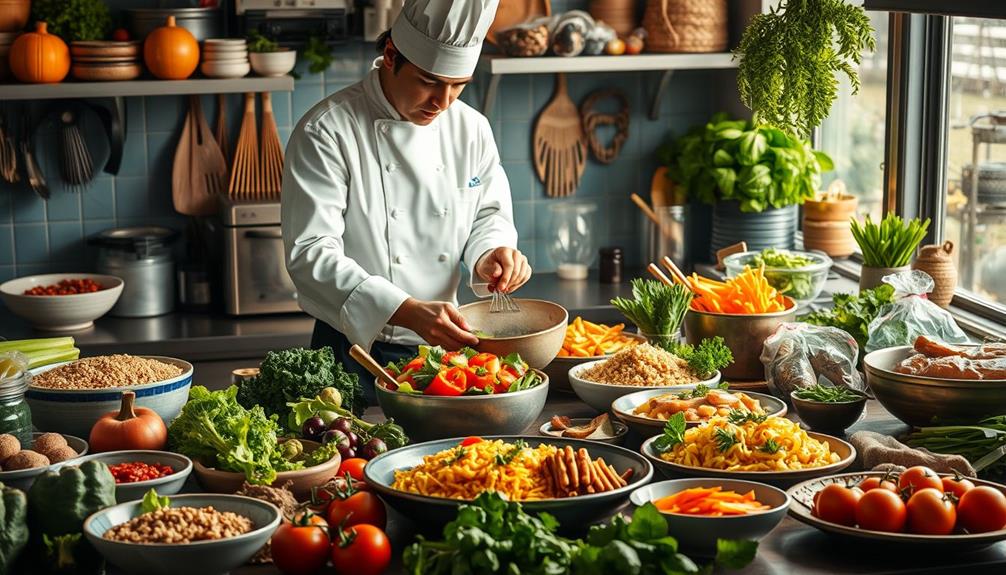To perfect your knife skills and achieve ideal textures, focus on proper grip and control, keeping fingers tucked and using a firm hold. Use a rocking motion with consistent pressure and comfortable angles to guarantee uniform slices. Keep your blades sharp to reduce slips and improve safety. Practice different cuts like dice, julienne, and chiffonade to enhance both presentation and texture. Continue exploring these techniques to elevate your culinary confidence and precision.
Key Takeaways
- Use a proper grip, pinching the blade near the bolster, for better control and precision.
- Employ a smooth rocking motion with gentle pressure to achieve even, clean cuts.
- Keep fingers curled inward with the claw grip to guide ingredients safely.
- Maintain a sharp knife to produce precise cuts and prevent slipping.
- Practice various cutting techniques like dicing, julienne, and chiffonade for consistent texture.

Ever wondered how professional chefs achieve perfectly uniform cuts and efficient prep work? It all starts with mastering basic knife skills, which are essential for both safety and precision. First, understanding knife safety is crucial. Always hold your knife firmly by the handle, keeping your fingers tucked away from the blade’s edge. Use a stable cutting surface and ensure your cutting board doesn’t slip—placing a damp towel underneath can help. When carrying a knife, hold it by the handle, pointing downward, to avoid accidents. Never try to catch a falling knife; step back and let it fall. Also, keep your knives sharp. Dull blades are more dangerous because they require more force and can slip easily, increasing the risk of injury. Regular sharpening techniques are vital; you can sharpen your knives with a whetstone, honing rod, or electric sharpener. Proper sharpening not only improves safety but also guarantees clean, precise cuts that enhance the texture of your ingredients.
Once your knives are sharp, you can focus on proper cutting techniques that promote uniformity and efficiency. The cornerstone is the grip: hold the handle comfortably with your dominant hand, and pinch the blade near the bolster (the thick part where the blade meets the handle). This grip gives you better control and reduces fatigue. Position your non-dominant hand to guide the food, curling your fingers inward to keep your fingertips protected. Your knuckles should act as a guide for the blade, guiding it through the ingredient with a rocking motion. Practice slicing with a smooth, consistent motion, applying gentle pressure to avoid crushing delicate items like herbs or soft fruits.
Using the claw grip with your non-dominant hand helps maintain control and safety, while also guaranteeing consistent slices. For example, when julienning vegetables, keep the pieces uniform by maintaining the same angle and pressure throughout each cut. As you gain confidence, experiment with different cutting styles—dice, julienne, chiffonade—each requiring specific techniques but sharing the same fundamentals of control and safety. Remember, a sharp knife combined with proper cutting technique saves you time and effort, resulting in better texture and presentation.
Frequently Asked Questions
What Are Common Mistakes to Avoid When Starting Raw Knife Skills?
If you’re not careful, you might fall into the trap of bad habits like improper knife grip or rushing your cutting speed. Remember, a secure grip helps control your cuts, preventing slips. Avoid rushing; steady, controlled movements lead to better results and safety. Don’t be the knight who rushes into battle—take your time, focus on proper technique, and refine your skills for perfect textures every time.
How Do I Choose the Best Knife for Raw Vegetable Slicing?
To select the best knife for raw vegetable slicing, focus on a sharp, high-quality blade made from durable material like stainless steel or high-carbon steel, which guarantees clean cuts. You should also prioritize a handle that feels comfortable in your hand, providing a secure grip without slipping. Test different weights and shapes to find what suits your slicing style best, making your prep safer and more efficient.
Are There Safety Tips for Handling Slippery Produce?
When handling slippery produce, you should always wear safety gear like cut-resistant gloves to protect your hands. Use a non-slip cutting surface to keep everything stable. Keep your fingers curled inward and hold the produce firmly to avoid slips. Take your time with each cut, and make sure your knife is sharp, so you don’t have to apply excessive force. These tips help prevent accidents and guarantee safe, efficient slicing.
How Do I Prevent Browning of Cut Fruits and Vegetables?
To prevent browning of cut fruits and vegetables, focus on oxidation prevention by applying lemon juice or vinegar, which slows down enzymatic reactions. Use proper storage techniques like airtight containers or wrapping tightly with plastic wrap to limit exposure to air. Keep produce refrigerated to slow oxidation and maintain freshness. These simple steps help retain color, flavor, and texture, ensuring your fruits and vegetables stay appealing longer after cutting.
What Maintenance Is Required to Keep Knives Sharp for Raw Prep?
To keep your knives sharp for raw prep, you should regularly perform knife sharpening using a whetstone or a sharpening steel, depending on your knife’s needs. Store your knives properly in a knife block or on a magnetic strip to prevent dulling. Avoid tossing them in drawers, which can damage the blades. Consistent maintenance guarantees your knives stay sharp, safe, and effective for precise cutting and prep.
Conclusion
Mastering raw knife skills isn’t just about precision—it’s about consistency that elevates your cooking. Did you know that proper technique can reduce prep time by up to 50%? So, keep practicing those cuts, and you’ll notice how easier and more enjoyable your cooking becomes. With these skills, you’ll create perfectly textured dishes every time. Stay sharp, and enjoy the confidence that comes with every precise slice!








